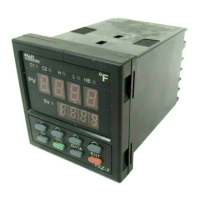APPENDIX B
Manual Tuning
Tune the PXZ controller if any of the following occurs:
• PXZ is installed in a new system
• PXZ is used as a replacement in an existing system
• The input sensor is relocated or changed
• The output device is relocated or changed
• The setpoint is significantly changed
• Any other condition that will alter the dynamics of the system
Proportional Band
The proportional band is a band around the setpoint of the PXZ where
the output is between 0% and 100%. The percentage of output is pro-
portional to the amount of error between the setpoint variable (SV)
and the process variable (PV). Outside of the proportional band the
output is either 0% or 100%
The proportional band on the PXZ is equidistant from the main set-
point as illustrated below.
An example of proportioning would be a vehicle approaching a stop
sign at an intersection. If the driver were traveling at 50mph and only
applied his brakes once at the intersection, his car would skid through
the intersection before coming to a full stop. This illustrates how
On/Off control acts. If, however, the driver started slowing down some
distance before the stop sign and continued slowing down at some
rate, he could conceivably come to a full stop at the stop sign. This
illustrates how proportional control acts. The distance where the
speed of the car goes from 50 to 0 MPH illustrates the proportional
band. As you can see, as the car travels closer to the stop sign, the
speed is reduced accordingly. In other words, as the error or distance
between the car and the stop sign becomes smaller, the output or
speed of the car is proportionally diminished. Figuring out when the
vehicle should start slowing down depends on many variables such
as speed, weight, tire tread, and braking power of the car, road condi-
tions, and weather much like figuring out the proportional band of a
control process with its many variables.
The width of the proportional band depends on the dynamics of the
system. The first question to ask is, how strong must my output be to
eliminate the error between the setpoint variable and process vari-
able? The larger the proportional band (low gain), the less reactive
the process. A proportional band too large, however, can lead to
process wandering or sluggishness. The smaller the proportional
band (high gain), the more reactive the output becomes. A proportion-
17
al band too small, however, can lead to over-responsiveness leading
to process oscillation.
A proportional band which is correct in width approaches main set-
point as fast as possible while minimizing overshoot. If a faster
approach to setpoint is desired and process overshoot is not a prob-
lem, a smaller or narrower proportional band may be used. This would
establish an over-damped system or one where the output would
change greatly, proportional to the error. If process overshoot cannot
be tolerated and the approach to setpoint does not have to be quick, a
larger or wider proportional band may be used. This would establish
an under-damped system or one where the output would change little,
proportional to the error.
Integral Time
With the proportional band alone, the process tends to reach equilib-
rium at some point away from the main setpoint. This offset is due to
the difference between the output needed to maintain setpoint and
the output of the proportional band at setpoint. In the case of the PXZ
controller where the proportional band is equidistant from the main
setpoint, the output is around 50%. If anything more or less than 50%
output is required to maintain setpoint, an offset error will occur.
Integral action eliminates this offset. See the diagrams below.
Integral action eliminates offset by adding to or subtracting from the
output of the proportional action alone. This increase or decrease in
output corrects for offset error within the proportional band in estab-
lishing steady-state performance at setpoint. It is not intended to cor-
rect for process disturbances. See the following diagram.
To Calculate Proportional Band:
Proportional Band Proportional Band
(as a percentage) =
____________________
X 100%
Input Range
Example:
30°C
3% =
__________
X 100%
100°C
Proportional Band
(as a percentage)
Proportional Band Range =
____________________
X 1000°C
100%
Example:
3%
30°C =
__________ x 1000°C
100%
Artisan Technology Group - Quality Instrumentation ... Guaranteed | (888) 88-SOURCE | www.artisantg.com

